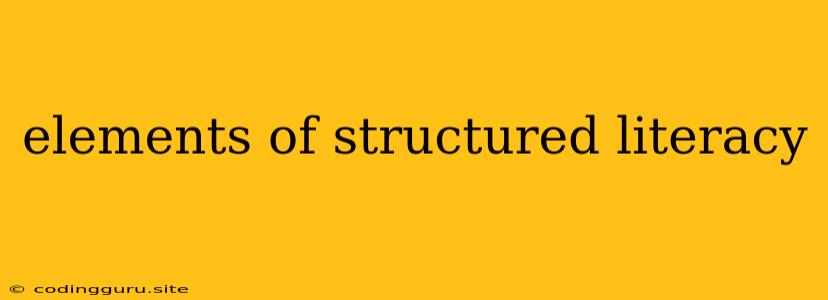Elements of Structured Literacy: A Comprehensive Guide for Effective Reading Instruction
Structured literacy is a highly effective approach to teaching reading that emphasizes the systematic and explicit instruction of foundational skills. It breaks down the complex process of reading into its essential components, allowing students to build a strong foundation for reading comprehension and fluency.
What are the essential elements of structured literacy?
Structured literacy encompasses a multifaceted approach that incorporates several key elements, each contributing to a comprehensive understanding of reading. These elements are interconnected and work together to create a robust framework for literacy development. Here's a breakdown of the essential elements:
1. Phonemic Awareness
This element focuses on the sounds of language, specifically the smallest units of sound called phonemes.
Key Questions:
- How do we break down words into their individual sounds?
- How do we identify the different sounds in spoken words?
- How do we manipulate sounds to form new words?
Strategies:
- Sound isolation: Identifying the initial, medial, and final sounds in words.
- Sound blending: Putting sounds together to form words.
- Sound segmentation: Breaking down words into their individual sounds.
- Phoneme deletion: Removing a sound from a word.
- Phoneme substitution: Replacing one sound in a word with another.
2. Phonics
Phonics is the connection between letters and sounds.
Key Questions:
- How do letters represent specific sounds?
- How do we use this knowledge to decode unknown words?
- What are the common letter patterns and their corresponding sounds?
Strategies:
- Explicit instruction of letter-sound correspondences: This includes the consistent use of a phonics chart or a systematic phonics program.
- Decoding practice: Activities like sounding out words, blending sounds, and using phonics rules to read unfamiliar words.
- Word sorts: Categorizing words based on shared sound patterns.
3. Morphology
Morphology explores the structure of words and how they are formed.
Key Questions:
- How do prefixes, suffixes, and roots contribute to word meaning?
- How can we analyze the structure of a word to understand its meaning?
- How can we use morphology to expand our vocabulary?
Strategies:
- Word analysis: Examining the parts of a word to determine its meaning.
- Morpheme identification: Identifying prefixes, suffixes, and root words.
- Word building: Creating new words by adding prefixes and suffixes.
- Vocabulary development: Using morphemic knowledge to learn new words.
4. Vocabulary
Vocabulary is the knowledge of words and their meanings.
Key Questions:
- How do we build a rich and varied vocabulary?
- How do we learn the meaning of new words?
- How do we use context clues to understand the meaning of unfamiliar words?
Strategies:
- Direct instruction of vocabulary: Explicitly teaching the meanings of new words through definitions, examples, and real-world applications.
- Vocabulary building activities: Using word maps, graphic organizers, and vocabulary games.
- Reading widely: Exposure to diverse texts introduces students to new words and concepts.
5. Syntax
Syntax refers to the rules that govern how words are arranged in sentences.
Key Questions:
- How do we understand the order of words in a sentence?
- How do we use grammatical rules to decode the meaning of sentences?
- How do we identify different sentence types and their structures?
Strategies:
- Sentence diagramming: Visualizing the relationships between words in a sentence.
- Identifying sentence parts: Recognizing subjects, verbs, objects, and other parts of speech.
- Analyzing sentence structure: Understanding the different types of sentences (declarative, interrogative, imperative, exclamatory) and their functions.
6. Reading Fluency
Reading fluency is the ability to read smoothly, accurately, and at an appropriate pace.
Key Questions:
- How can we improve our reading rate and accuracy?
- How do we develop expression and prosody in reading?
- How do we use fluency to enhance comprehension?
Strategies:
- Repeated reading: Practicing reading passages multiple times to increase fluency.
- Choral reading: Reading aloud together with others to improve pacing and expression.
- Timed reading: Tracking reading speed and accuracy.
- Phrased reading: Reading in meaningful chunks to improve comprehension.
7. Reading Comprehension
Reading comprehension is the ability to understand and interpret what is read.
Key Questions:
- How do we make sense of the information in a text?
- How do we draw inferences and connect ideas from the text?
- How do we analyze text features and structures to improve comprehension?
Strategies:
- Active reading strategies: Using graphic organizers, summarizing, questioning, and predicting to engage with text.
- Text-to-self, text-to-world, and text-to-text connections: Making connections between the text and the reader's own experiences, the world, and other texts.
- Critical thinking skills: Analyzing arguments, identifying bias, and evaluating evidence.
Conclusion
Structured literacy provides a comprehensive and systematic framework for teaching reading, empowering students to become confident and proficient readers. By addressing the interconnected elements of phonemic awareness, phonics, morphology, vocabulary, syntax, reading fluency, and reading comprehension, structured literacy sets the stage for lifelong literacy success.
